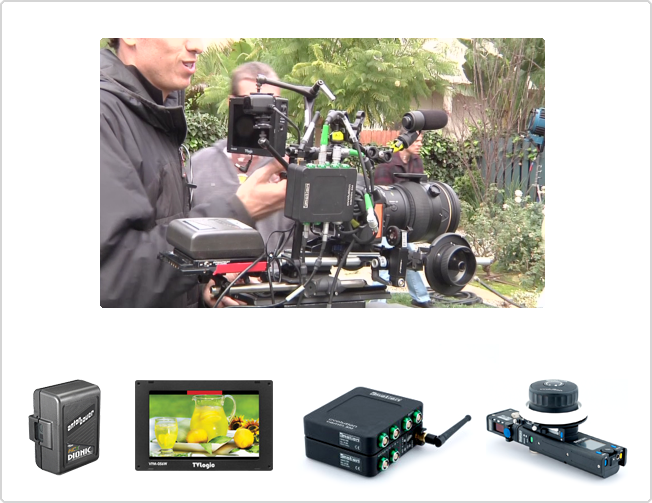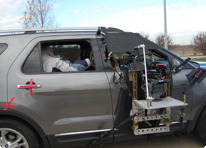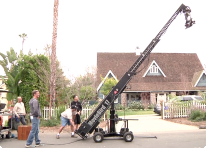
Production means filming, or with video cameras, recording. Ordinarily, films are shot at 24 or 25 frames per second (FPS) and videos at 25 or 30. While filming, the subject moves, filming angles and camera positions change, and so on. Thus, depending on the subject, the location, and the camera work, a fantastic number of filming possibilities emerges. Here we see how the D800 was used in the production of "Through The Lens," which was planned and executed in the same manner as a feature length film, and whether it met the demands of professional moviemakers. The content will also introduce examples of camera work never used in still photography.
It takes a lot more work to set up and fix a camera in place to take motion pictures than it does to prepare for a still shoot. The camera must be set up so it can pan or tilt precisely and smoothly, allowing the cinematographer to effectively accomplish the camerawork he has in mind. Basically, this is how it works. First, a large tripod is set up precisely horizontal and sandbagged in place. Atop the tripod comes the camera head, which will accept the camera itself. For the D800, it was necessary to make a special adapter to fit the movie camera head. When shooting with a handheld rig, the cinematographer uses a shoulder grip, and the D800 had to have a special adapter for that as well. Crew members called "grips" are in charge of setting up and fixing the cameras in place, and the "key grip" is the team leader.



Filming by shoulder grip
While the grip and camera crews prepare the cameras, the electrical department, led by the gaffer, arranges the lighting. Once the camera is ready, the aperture settings are finalized and the lighting is set accordingly. In most cases, ISO is set to 100 and the shutter speed to 1/50 s to achieve a cinematographic appearance. Depending on the amount of light available or provided by the lighting, there are times when the shutter speed is changed to make a quick adjustment but in most cases, this is done with the aperture and ND filters. For this movie, HMI lights were used because their color temperature is 5,500 K, the same color as sunlight, and are not prone to flicker.

In feature film production, the camerawork, shooting, and aperture decisions are handled by the DP. The first assistant cameraman (1st AC) is in charge of focusing and the 2nd AC takes care of the equipment. This separation of responsibilities allows the DP to concentrate on keeping the actors properly in the frame as they move through the scene. For this film, all the scenes were shot manually, but the aperture was set and focus adjusted by remote control while watching externally output video images on two monitors. In principle, the shots were stored in the CF card inside the D800, but for certain scenes, HDMI output images were stored on external recording equipment. On-scene background sounds were recorded with the external microphone attached to the D800.


Adjusting aperture while watching a waveform
Anton/Bauer
DIONIC HCX
124Wh Li-Ion battery
TVlogic
5.6" Light Weight Compact Field Monitor
VFM-056W
Cvolution
Motor control unit
Camin 8M
Cvolution
Wireless operation system
Cvolution hand unit

The challenge of using a moving camera for cinematography is one of the most interesting aspects of moviemaking. To accomplish this, the DP can draw on many types of specialized equipment. Dollies, for example, allow the camera to move horizontally as well as vertically to follow the scene as it unfolds. One scene in "Through The Lens" photographed the boy through a birdcage, and another had the camera following the boy and his father in a supermarket. The opening scene used a telescoping crane called a Technocrane to shoot the young girl delivering newspapers from high above. A camera mounted on a specially adapted Porsche Cayenne was also used to shoot this film. The camera was mounted to the Gemini crane affixed to the roof of the car with a gyro-stabilized three-axis Libra mount to photograph the school bus and other driving scenes. Other scenes shot inside the car used special mounts including one nicknamed a 'hostess tray' to affix the camera to the moving car.
In these situations, the D800, which is lighter and more compact than the cameras generally used to shoot feature films, was easier to manipulate. The D800 is not only compact, but its large sensor also gives it the edge in close-up scenes inside the car that required wide-angle lenses. The D800's large sensor and wide-angle lenses were a perfect combination, so the cinematographer was able to include both the father, who was driving, and the boy, in the same shot from the same angle with no image distortion, without sacrificing the depth of field.





At the beginning of the film, the time-lapse scene of the expressway was shot with four D800 cameras using different speeds and different lenses, and the best results from the four were chosen. Time-lapse photography takes much longer than normal photography, and it is impossible to tell how good the images will be until the entire sequence is shot and reviewed. There was only one chance to shoot this scene, which aimed to show rush-hour traffic on the expressway shot against a twilight sky. If the take had not been successful, it would have had to be shot again on another day. So shooting it with more than one camera to make the most of the production's tight schedule turned out to be an excellent move.
